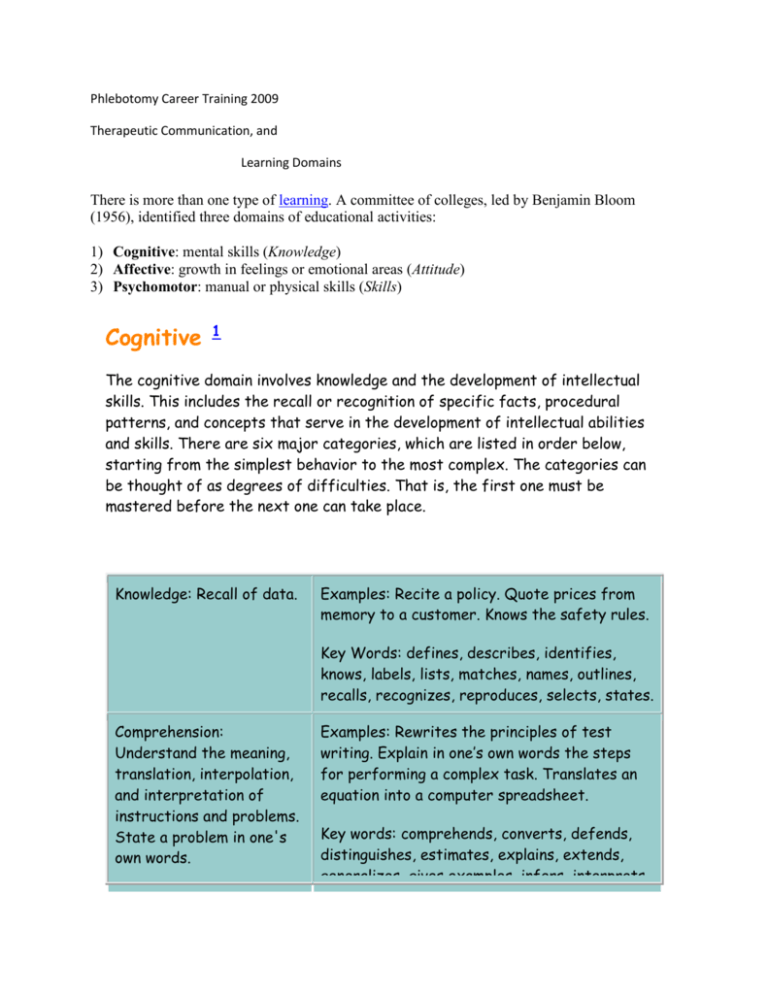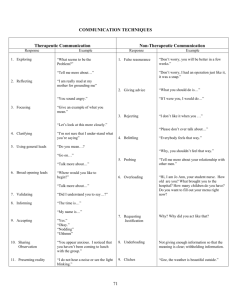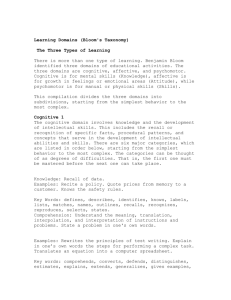Phlebotomy-Therapeutic-Communication
advertisement

Phlebotomy Career Training 2009 Therapeutic Communication, and Learning Domains There is more than one type of learning. A committee of colleges, led by Benjamin Bloom (1956), identified three domains of educational activities: 1) Cognitive: mental skills (Knowledge) 2) Affective: growth in feelings or emotional areas (Attitude) 3) Psychomotor: manual or physical skills (Skills) Cognitive 1 The cognitive domain involves knowledge and the development of intellectual skills. This includes the recall or recognition of specific facts, procedural patterns, and concepts that serve in the development of intellectual abilities and skills. There are six major categories, which are listed in order below, starting from the simplest behavior to the most complex. The categories can be thought of as degrees of difficulties. That is, the first one must be mastered before the next one can take place. Knowledge: Recall of data. Examples: Recite a policy. Quote prices from memory to a customer. Knows the safety rules. Key Words: defines, describes, identifies, knows, labels, lists, matches, names, outlines, recalls, recognizes, reproduces, selects, states. Comprehension: Understand the meaning, translation, interpolation, and interpretation of instructions and problems. State a problem in one's own words. Examples: Rewrites the principles of test writing. Explain in one’s own words the steps for performing a complex task. Translates an equation into a computer spreadsheet. Key words: comprehends, converts, defends, distinguishes, estimates, explains, extends, generalizes, gives examples, infers, interprets, paraphrases, predicts, rewrites, summarizes, translates. Application: Use a concept in a new situation or unprompted use of an abstraction. Applies what was learned in the classroom into novel situations in the workplace. Examples: Use a manual to calculate an employee’s vacation time. Apply laws of statistics to evaluate the reliability of a written test. Analysis: Separates material or concepts into component parts so that its organizational structure may be understood. Distinguishes between facts and inferences. Examples: Troubleshoot a piece of equipment by using logical deduction. Recognize logical fallacies in reasoning. Gathers information from a department and selects the required tasks for training. Synthesis: Builds a structure or pattern from diverse elements. Put parts together to form a whole, with emphasis on creating a new meaning or structure. Examples: Write a company operations or process manual. Design a machine to perform a specific task. Integrates training from several sources to solve a problem. Revises and process to improve the outcome. Key Words: applies, changes, computes, constructs, demonstrates, discovers, manipulates, modifies, operates, predicts, prepares, produces, relates, shows, solves, uses. Keywords: analyzes, breaks down, compares, contrasts, diagrams, deconstructs, differentiates, discriminates, distinguishes, identifies, illustrates, infers, outlines, relates, selects, separates. Keywords: categorizes, combines, compiles, composes, creates, devises, designs, explains, generates, modifies, organizes, plans, rearranges, reconstructs, relates, reorganizes, revises, rewrites, summarizes, tells, writes. Evaluation: Make judgments about the value of ideas or materials. Examples: Select the most effective solution. Hire the most qualified candidate. Explain and justify a new budget. Keywords: appraises, compares, concludes, contrasts, criticizes, critiques, defends, describes, discriminates, evaluates, explains, interprets, justifies, relates, summarizes, supports. 4) 5) Affective 2 This domain includes the manner in which we deal with things emotionally, such as feelings, values, appreciation, enthusiasms, motivations, and attitudes. The five major categories listed in order are: Receiving phenomena: Awareness, willingness to hear, selected attention. Examples: Listen to others with respect. Listen for and remember the name of newly introduced people. Keywords: asks, chooses, describes, follows, gives, holds, identifies, locates, names, points to, selects, sits, erects, replies, uses. Responding to phenomena: Active participation on the part of the learners. Attends and reacts to a particular phenomenon. Learning outcomes may emphasize compliance in responding, Examples: Participates in class discussions. Gives a presentation. Questions new ideals, concepts, models, etc. in order to fully understand them. Know the safety rules and practices them. Keywords: answers, assists, aids, complies, conforms, discusses, greets, helps, labels, willingness to respond, or satisfaction in responding (motivation). performs, practices, presents, reads, recites, reports, selects, tells, writes. Valuing: The worth or value a person attaches to a particular object, phenomenon, or behavior. This ranges from simple acceptance to the more complex state of commitment. Valuing is based on the internalization of a set of specified values, while clues to these values are expressed in the learner’s overt behavior and are often identifiable. Examples: Demonstrates belief in the democratic process. Is sensitive towards individual and cultural differences (value diversity). Shows the ability to solve problems. Proposes a plan to social improvement and follows through with commitment. Informs management on matters that one feels strongly about. Organization: Organizes values into priorities by contrasting different values, resolving conflicts between them, and creating an unique value system. The emphasis is on comparing, relating, and synthesizing values. Examples: Recognizes the need for balance between freedom and responsible behavior. Accepts responsibility for one’s behavior. Explains the role of systematic planning in solving problems. Accepts professional ethical standards. Creates a life plan in harmony with abilities, interests, and beliefs. Prioritizes time effectively to meet the needs of the organization, family, and self. Keywords: completes, demonstrates, differentiates, explains, follows, forms, initiates, invites, joins, justifies, proposes, reads, reports, selects, shares, studies, works. Keywords: adheres, alters, arranges, combines, compares, completes, defends, explains, formulates, generalizes, identifies, integrates, modifies, orders, organizes, prepares, relates, synthesizes. Internalizing values Examples: Shows self-reliance when working (characterization): Has a value system that controls their behavior. The behavior is pervasive, consistent, predictable, and most importantly, characteristic of the learner. Instructional objectives are concerned with the student's general patterns of adjustment (personal, social, emotional). Psychomotor independently. Cooperates in group activities (displays teamwork). Uses an objective approach in problem solving. Displays a professional commitment to ethical practice on a daily basis. Revises judgments and changes behavior in light of new evidence. Values people for what they are, not how they look. Keywords: acts, discriminates, displays, influences, listens, modifies, performs, practices, proposes, qualifies, questions, revises, serves, solves, verifies. 3 The psychomotor domain includes physical movement, coordination, and use of the motor-skill areas. Development of these skills requires practice and is measured in terms of speed, precision, distance, procedures, or techniques in execution. The seven major categories listed in order are: Perception: The ability to use sensory cues to guide motor activity. This ranges from sensory stimulation, through cue selection, to translation. Examples: Detects non-verbal communication cues. Estimate where a ball will land after it is thrown and then moving to the correct location to catch the ball. Adjusts heat of stove to correct temperature by smell and taste of food. Adjusts the height of the forks on a forklift by comparing where the forks are in relation to the pallet. Keywords: chooses, describes, detects, differentiates, distinguishes, identifies, isolates, relates, selects. Set: Readiness to act. It includes mental, physical, and emotional sets. These three sets are dispositions that predetermine a person’s response to different situations (sometimes called mindsets). Examples: Knows and acts upon a sequence of steps in a manufacturing process. Recognize one’s abilities and limitations. Shows desire to learn a new process (motivation). NOTE: This subdivision of Psychomotor is closely related with the "Responding to phenomena" subdivision of the Affective domain. Guided response: The early stages in learning a complex skill that includes imitation and trial and error. Adequacy of performance is achieved by practicing. Examples: Performs a mathematical equation as demonstrated. Follows instructions to build a model. Responds hand-signals of instructor while learning to operate a forklift. Mechanism: This is the intermediate stage in learning a complex skill. Learned responses have become habitual and the movements can be performed with some confidence and proficiency. Examples: Use a personal computer. Repair a leaking faucet. Drive a car. Complex Overt Response: The skillful performance of motor acts that involve complex movement patterns. Proficiency is indicated by a quick, accurate, and highly Examples: Maneuvers a car into a tight parallel parking spot. Operates a computer quickly and accurately. Displays competence while playing the piano. Keywords: begins, displays, explains, moves, proceeds, reacts, shows, states, volunteers. Keywords: copies, traces, follows, react, reproduce, responds Keywords: assembles, calibrates, constructs, dismantles, displays, fastens, fixes, grinds, heats, manipulates, measures, mends, mixes, organizes, sketches. Keywords: assembles, builds, calibrates, constructs, dismantles, displays, fastens, fixes, coordinated performance, requiring a minimum of energy. This category includes performing without hesitation, and automatic performance. For example, players are often utter sounds of satisfaction or expletives as soon as they hit a tennis ball or throw a football, because they can tell by the feel of the act what the result will produce. grinds, heats, manipulates, measures, mends, mixes, organizes, sketches. NOTE: The key words are the same as Mechanism, but will have adverbs or adjectives that indicate that the performance is quicker, better, more accurate, etc. Adaptation: Skills are well developed and the individual can modify movement patterns to fit special requirements. Examples: Responds effectively to unexpected experiences. Modifies instruction to meet the needs of the learners. Perform a task with a machine that it was not originally intended to do (machine is not damaged and there is no danger in performing the new task). Keywords: adapts, alters, changes, rearranges, reorganizes, revises, varies. Origination: Creating new movement patterns to fit a particular situation or specific problem. Learning outcomes emphasize creativity based upon highly developed skills. Examples: Constructs a new theory. Develops a new and comprehensive training programming. Creates a new gymnastic routine. Keywords: arranges, builds, combines, composes, constructs, creates, designs, initiate, makes, originates. 6) What is Therapeutic Communication? Nursing is a caring profession. It is also a profession that is more and more evidenced based in practice. In as much as the scientific aspects of nursing is increasing due to the complex technological advancement of medicine and the machinery that is used at the patients bedside, the fact remains that the nurse is the first person that the client usually comes in contact with in any emergency or hospital setting. Having said this, the term, "caring" is an essential emotion that all nurses, for that matter, all individuals in the health profession must possess. With caring comes the trained ability of the nurse to facilitate therapeutic communication. One might ask, what is therapeutic communication? To better answer this question, the term communication should first be defined. Communication can be defined as "The Process of transmitting messages and interpreting meaning." (Wilson and others, 1995) With therapeutic communication, the sender, or nurse seeks to illicit a response from the receiver, the patient that is beneficial to the patients mental and physical health. Just as stress has been proven to adversely affect the health of individuals, the therapeutic approach to communication can actually help. In any given situation everyone uses communication. Everyone has seen the individual that looks like they are either angry, stressed, feeling ill or maybe sad. These emotions are communicated to others not always by words, but by gestures and facial expressions. A nurse must always be aware of these expressions in clients, for these expressions may be the only way that the nurse can tell if there is something else going on that needs their attention. The term given to this type of non-verbal communication is called, metacommunication. In meta-communication, the client may look at their amputated stump and say that it doesn't really look that bad, while at the same time tears are rolling down from their eyes. In a case such as this the nurse should stay and further explore how the person actually feels. There are many factors associated with the healing and comforting aspects of therapeutic communication. Circumstances, surroundings, and timing all play a role in the effect of therapeutic communication. If a client is being rushed down for an emergency surgery there might not be time for a bedside conversation, but the holding of a hand could convey much more than words to the client at such a moment. Ideally, for therapeutic communication to be effective the nurse must be aware of how they appear to the client. If a nurse appears rushed, for example, they are speaking quickly, their countenance looks harried, and they are breathing heavily, their eyes not on the client but perhaps on an intravenous bag on the client in the next bed. In a case like this, there is nothing that this nurse could say to the client in a therapeutic manner that the client would believe. The helping relationship has not been established and therefore therapeutic communication cannot be facilitated. Some of the emotions associated with therapeutic communication include but are not limited to the following: Professionalism, Confidentiality, Courtesy, Trust, Availability, Empathy, and Sympathy. (Potter, Patricia A., Perry, Anne G., Co. 2003, Basic Nursing Essentials for Practice, pg. 123, Mosby) All of these emotions go into the client nurse relationship, which must be established by the nurse as soon as possible upon first meeting the client. To begin to establish this nurse client relationship, the nurse must assess the overall message that the client is communicating to the nurse, such as fear, pain, sadness, anxiety or apathy. The nurse should be trained in keying into the message that the client is sending. Only then can the nurse determine the best therapeutic approach. Anyone that has to be thrust in to a hospital or emergency room environment has level of anxiety. This level can go up considerably when the client feels that they have been abandoned or that there is no one there that really cares about how they feel. When a client is the recipient of therapeutic communication from a caring individual, a level of trust is achieved and more than, that the clients entire countenance can change for the better. Their blood pressure, respirations and levels of stress can simultaneously decrease. When this takes place, the management of pain, if any is involved, can be resolved more quickly. The goal for a nurse is to become proficient in the medical








